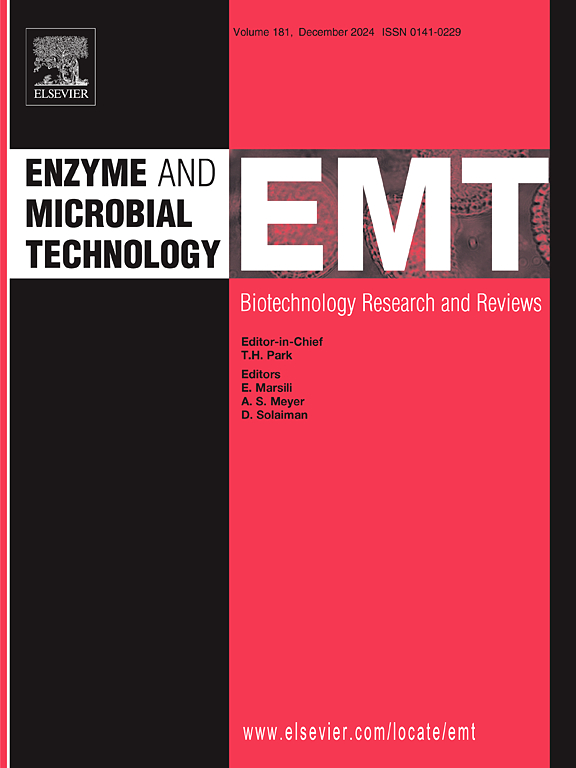Psychrophilic insights into petroleum degradation: Gene abundance dynamics
IF 3.7
3区 生物学
Q2 BIOTECHNOLOGY & APPLIED MICROBIOLOGY
引用次数: 0
Abstract
Petroleum degradation by psychrophiles can be enhanced on the basis of omics analyses, which offer better sensitivity than traditional biochemical methods do. A metagenomic analysis focusing on gene abundance comparisons may provide new guidance to optimize soil decontamination under cold environmental conditions. The soil used in this study was sampled from Dalian, from which an indigenous consortium was isolated. The degradative soil systems, initially categorized into control (DLC) and experimental (DLD) groups, were kept at room temperature (20 ± 5 °C) for six weeks. The DLD group was subsequently transferred to a low-temperature environment (5–10 °C) for 90 days and renamed DDL. A petroleum removal rate of 74.59 % was achieved in the process from DLD to DDL groups. Each soil sample was subjected to analysis and metagenomic sequencing. The abundance of genes of interest was compared between pathways to determine trends. The findings demonstrate that psychrophilic degradation is more effective than natural remediation is. The soil microbial community structure displayed site specificity, with 802 genes in DDL associated with 249 pathways, indicating greater abundance of psychrophilic genes in DDL than in DLC. The abundance of key genes was at different orders of magnitude but showed similar trends. The abundance of genes associated with hydrocarbon-related metabolism surpassed that of genes associated with sphingolipid, fatty acid, or benzene metabolism. This study provides valuable insights into psychrophilic microbe-driven petroleum degradation and indicates the need for precise supplementation of biosurfactants to improve remediation efficiency.
石油降解的亲水性洞察:基因丰度动力学
在组学分析的基础上,可以增强嗜冷菌对石油的降解,这比传统的生化方法具有更好的灵敏度。以基因丰度比较为重点的宏基因组分析可能为优化寒冷环境下土壤去污提供新的指导。本研究中使用的土壤取样自大连,从那里分离出一个土着联合体。将退化土壤系统分为对照组(DLC)和试验组(DLD),在室温(20 ± 5°C)下保存6周。随后将DLD组转移至低温环境(5-10℃)90天,并更名为DDL。从DLD到DDL基团的原油去除率为74.59 %。每个土壤样品进行分析和宏基因组测序。通过比较不同途径间感兴趣的基因的丰度来确定趋势。研究结果表明,亲冷降解比自然修复更有效。土壤微生物群落结构表现出位点特异性,DDL中有802个基因与249条途径相关,表明DDL中嗜冷基因的丰度高于DLC。关键基因的丰度在不同的数量级上,但表现出相似的趋势。与烃类代谢相关的基因丰度超过了与鞘脂、脂肪酸或苯代谢相关的基因。该研究为研究嗜冷微生物驱动的石油降解提供了有价值的见解,并表明需要精确补充生物表面活性剂来提高修复效率。
本文章由计算机程序翻译,如有差异,请以英文原文为准。
求助全文
约1分钟内获得全文
求助全文
来源期刊

Enzyme and Microbial Technology
生物-生物工程与应用微生物
CiteScore
7.60
自引率
5.90%
发文量
142
审稿时长
38 days
期刊介绍:
Enzyme and Microbial Technology is an international, peer-reviewed journal publishing original research and reviews, of biotechnological significance and novelty, on basic and applied aspects of the science and technology of processes involving the use of enzymes, micro-organisms, animal cells and plant cells.
We especially encourage submissions on:
Biocatalysis and the use of Directed Evolution in Synthetic Biology and Biotechnology
Biotechnological Production of New Bioactive Molecules, Biomaterials, Biopharmaceuticals, and Biofuels
New Imaging Techniques and Biosensors, especially as applicable to Healthcare and Systems Biology
New Biotechnological Approaches in Genomics, Proteomics and Metabolomics
Metabolic Engineering, Biomolecular Engineering and Nanobiotechnology
Manuscripts which report isolation, purification, immobilization or utilization of organisms or enzymes which are already well-described in the literature are not suitable for publication in EMT, unless their primary purpose is to report significant new findings or approaches which are of broad biotechnological importance. Similarly, manuscripts which report optimization studies on well-established processes are inappropriate. EMT does not accept papers dealing with mathematical modeling unless they report significant, new experimental data.
 求助内容:
求助内容: 应助结果提醒方式:
应助结果提醒方式:


